中英诗歌对比赏析·中西文化差异共20页
- 格式:ppt
- 大小:2.62 MB
- 文档页数:20
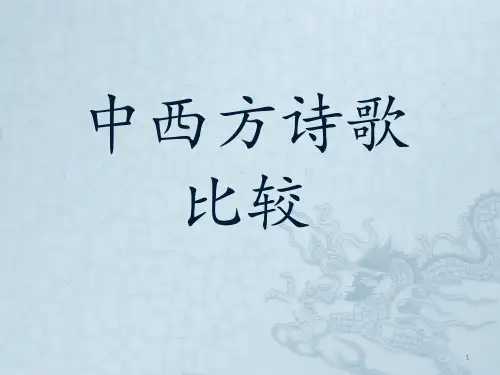


xx诗歌文化异同前言中西之间的差异毫无疑问是显而易见的。
西方人讲究精准确切,而中国人虽说离不开客观事物,但却更注重一种意境上的领悟。
在饮食上,西方注重营养与科学,烹调要求规范化,相同的菜肴在地区之间差异并不大。
而中国则更注重味觉,也更随意,厨师可以按自己的喜好和习惯对菜品进行加工改进,并不遵从菜谱上的配料比例。
在绘画上,西方的传统是极度写实的素描与油画,注重透视的准确及光与影的再现。
而中国则是水墨画,或缥缈或厚重,跟实物相差颇多,但对神韵的把握则是共同的。
在哲学上,爱因斯坦曾经这样评价过西方的科学发展:“西方科学的发展是以两个伟大的成就为基础,那就是:希腊哲学家发明形式逻辑体系,以及通过系统的实验发现有可能找出因果关系。
”西方的哲学强调形式逻辑,强调推导论证。
而中国则在更大程度上是一种“悟”,一种感觉。
正如老子的《道德经》,“道可道,非常道”。
究竟道是什么,很难有人给出一个标准答案。
道存在于心中,很多时候是一种悟出来的感觉。
又如在中国影响深远的哲学观点“天人合一”。
我即是天地,天地即是我,两者是统一起来,可以相互转化的。
在这种哲学观念的影响下,中国人自然更注重主观的感受,而逻辑性上缺乏重视。
这个区别在文化上的反应是直观的。
xx诗歌的差异一、情感表达差异英文诗歌大都表达热切,感情激烈,以求再现此情。
而中国的古诗词则文字简洁,意境悠远。
诗人将想要表达的意思表达到七八分后,便会打住,留白出来以给人遐想的空间。
李白的那首闻名的《静夜思》便是中文诗歌中的一个典型。
通篇文字都很简单,描绘的情景其实也很简单。
不过是看到夜晚起床之后看到空中一轮明月后,开始思念了家乡。
但这一仰头一低头之间的风致却打动了几乎所有的中国人,吸引了一代代的国人竞相传唱。
而这种感情在西方人看来似乎是难以理解的。
Tr. W. J. B. Fletcher在翻译静夜思时,将“举头望明月,低头思故乡”这两句译做了“On her clear face I gazed with lifted eyes:then hide them full of Youth’s sweet memories.”Fletcher显然没能理解到诗中的那种思乡的感觉。

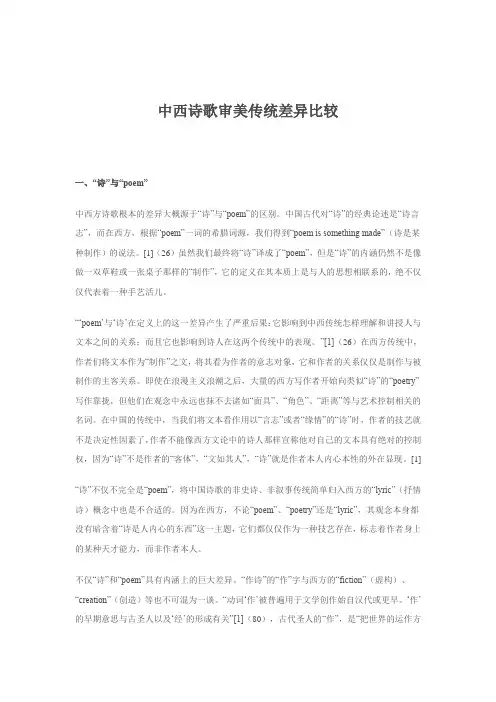
中西诗歌审美传统差异比较一、“诗”与“poem”中西方诗歌根本的差异大概源于“诗”与“poem”的区别。
中国古代对“诗”的经典论述是“诗言志”,而在西方,根据“poem”一词的希腊词源,我们得到“poem is something made”(诗是某种制作)的说法。
[1](26)虽然我们最终将“诗”译成了“poem”,但是“诗”的内涵仍然不是像做一双草鞋或一张桌子那样的“制作”,它的定义在其本质上是与人的思想相联系的,绝不仅仅代表着一种手艺活儿。
“…poem‟与…诗‟在定义上的这一差异产生了严重后果:它影响到中西传统怎样理解和讲授人与文本之间的关系;而且它也影响到诗人在这两个传统中的表现。
”[1](26)在西方传统中,作者们将文本作为“制作”之文,将其看为作者的意志对象,它和作者的关系仅仅是制作与被制作的主客关系。
即使在浪漫主义浪潮之后,大量的西方写作者开始向类似“诗”的“poetry”写作靠拢,但他们在观念中永远也抹不去诸如“面具”、“角色”、“距离”等与艺术控制相关的名词。
在中国的传统中,当我们将文本看作用以“言志”或者“缘情”的“诗”时,作者的技艺就不是决定性因素了,作者不能像西方文论中的诗人那样宣称他对自己的文本具有绝对的控制权,因为“诗”不是作者的“客体”,“文如其人”,“诗”就是作者本人内心本性的外在显现。
[1]“诗”不仅不完全是“poem”,将中国诗歌的非史诗、非叙事传统简单归入西方的“lyric”(抒情诗)概念中也是不合适的。
因为在西方,不论“poem”、“poetry”还是“lyric”,其观念本身都没有暗含着“诗是人内心的东西”这一主题,它们都仅仅作为一种技艺存在,标志着作者身上的某种天才能力,而非作者本人。
不仅“诗”和“poem”具有内涵上的巨大差异。
“作诗”的“作”字与西方的“fiction”(虚构)、“creation”(创造)等也不可混为一谈。
“动词…作‟被普遍用于文学创作始自汉代或更早。
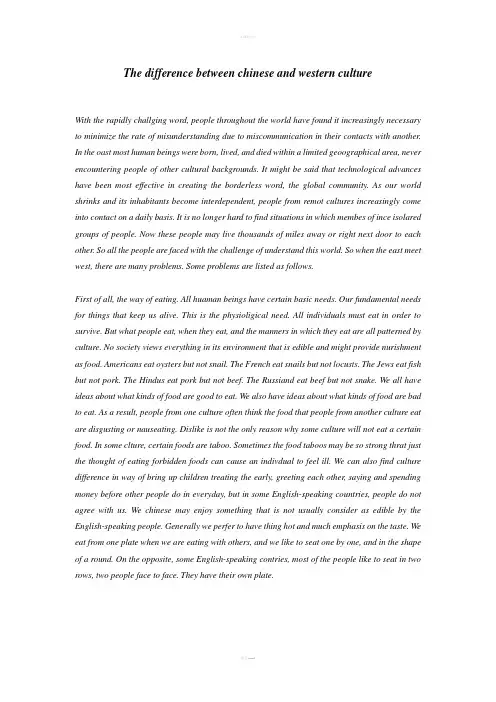
The difference between chinese and western cultureWith the rapidly challging word, people throughout the world have found it increasingly necessary to minimize the rate of misunderstanding due to miscommunication in their contacts with another. In the oast most human beings were born, lived, and died within a limited geoographical area, never encountering people of other cultural backgrounds. It might be said that technological advances have been most effective in creating the borderless word, the global community. As our world shrinks and its inhabitants become interdependent, people from remot cultures increasingly come into contact on a daily basis. It is no longer hard to find situations in which membes of ince isolared groups of people. Now these people may live thousands of miles away or right next door to each other. So all the people are faced with the challenge of understand this world. So when the east meet west, there are many problems. Some problems are listed as follows.First of all, the way of eating. All huaman beings have certain basic needs. Our fundamental needs for things that keep us alive. This is the physioligical need. All individuals must eat in order to survive. But what people eat, when they eat, and the manners in which they eat are all patterned by culture. No society views everything in its environment that is edible and might provide nurishment as food. Americans eat oysters but not snail. The French eat snails but not locusts. The Jews eat fish but not pork. The Hindus eat pork but not beef. The Russiand eat beef but not snake. We all have ideas about what kinds of food are good to eat. We also have ideas about what kinds of food are bad to eat. As a result, people from one culture often think the food that people from another culture eat are disgusting or nauseating. Dislike is not the only reason why some culture will not eat a certain food. In some clture, certain foods are taboo. Sometimes the food taboos may be so strong thrat just the thought of eating forbidden foods can cause an indivdual to feel ill. We can also find culture difference in way of bring up children treating the early, greeting each other, saying and spending money before other people do in everyday, but in some English-speaking countries, people do not agree with us. We chinese may enjoy something that is not usually consider as edible by the English-speaking people. Generally we perfer to have thing hot and much emphasis on the taste. We eat from one plate when we are eating with others, and we like to seat one by one, and in the shape of a round. On the opposite, some English-speaking contries, most of the people like to seat in two rows, two people face to face. They have their own plate.On the aspect of table manners, there are many differences between chinese and English-speaking people. For example, in some Englishi-speaking countries, Bread plates are to the left of the main plate, beverage glasses are to the right. Salad fork, knife and soup spoon are further from the main plate than the main course knife, fork and spoon. When eating bread rolls, break off a piece before buttering. Use the knife only to butter the bread, not to cut it. They should not start eating before your host does or instructs to do so. At larger meals, it is considered okay to start eating once others have been served. When finished, place the knife and fork together at five o’clock with the fork on the left. It is considered rude to answer the telephone at the table. If need to take an urgent call, excuse self and go outside. Try to eat all the food you are served. But in China, the table manners are different. Chinese traditionally eat rice from a small bowl held in the left hand. The rice bowl is raised to the mouth and the rice pushed into the mouth using the chopsticks. Some Chinese find it offensive to scoop rice from the bowl using a spoon. If rice is served on a plate, as is more common in the West, it is acceptable and more practical to eat it with a fork or spoon. The thumb must always be above the edge of the bowl. The host should always make sure the guests drinks are sufficiently full. One should not pour for ones self, but should offer to pour for a neighbor. When your drink is being poured, you should say "thank you" and tap fingers on the table to show appreciation. When people wish to clink drinks together in the form of a cheer, it is important to observe that younger members should clink the edge of their drink below the edge of an elder to show respect.Secondly, the way of communication. Form birth to death, communication plays an integral part in our life. There are some language problems, including the different styles of using language such as direct, indirect; expansive, succinct; argumentative, conciliatory; instrumental, harmonnizing; and so on. These different styles can lead to wrong interpretations of intent and evaluation of insincerity, aggreeiveness, deviousness, or arrogance, among other. The misinterpretation nonverbal signs and symbols such as gestures, postures, and other body movements. It is a definite communication barrier. But it is possible to learn the meanings of these observable message,usually in informal rather ways. It is more difficult to understand the less obvious unspoken codes of the other cultures.Language, as the carrier of cul ture, is created during the process of human beings’ productive labor and serves as the tool of communication to convey the message between people. However, it has been endowed with magic and power in particular language acts. As the old saying goes, troubles come out of the tongue. Superstitious people think that the language itself can bring about fortune or misfortune so that taboos to restrict the use of language are created. Anyone who violates them will get punishment, whereas those who faithfully obey the restrictions of language taboo will get protection. Furthermore, linguistic taboos change with the development of society .The paper firstly analyzes the evolution of linguistic taboo. It is indicated in the paper that linguistic taboo exists in almo st every aspect of people’s life and is a universal social phenomenon in China and Britain. Both Chinese and English cultures are in agreement about linguistic taboos such as pronunciation taboo, and vocabulary taboo. However, influenced by different cultural backgrounds, ideologies and the concepts of value, Chinese and English linguistic taboos also have differences, as is discussed in the paper from the aspects of taboo subjects, taboo numbers and names. At last, this paper puts forward two effective ways of avoiding taboo, that is, using euphemism and having a good knowledge of the taboo culture. And this discussion would help English learners improve their ability of cross-cultural communication and achieve better communicational effects. For example, During the feudal times, people were not equal to the rulers and were suppressed by their superiors. The distinction between the upper and the lower classes was also reflected in the evaluation of the language used by them respectively. The words of upper class used were considered good and elegant while those used by the lower class were regarded as vulgar and indecent and should be avoided in the speech of ladies and gentlemen. In modern society, as a result of the development of science and technology, many natural phenomena are no longer mysterious. Human beings not only constantly improve their abilities to exploit the world where they are living through their great wisdom and knowledge, but also make efforts to explore the extraterrestrial world. Science has much more say in today’s society. Thereby, the superstitious elements in linguistic taboos decrease while those reflecting spiritual civilization increase.In short, by comparison, we can find that both Chinese and English communication reflect peopl e’s psychology for good will, for safety and fortune and pleasantness. The Chinese and English people restrict their words and deeds through taboos, trying to keep a harmonious relationship between human and nature, or between people and society. They are a reflection of people’s pursuit of freedom and equality.The most important, the different way of family structure, family values and family education. Family structure is the big difference between east and west, traditional chinese, amony many other Asians, repect their elders and feel a deep sense of duty toward them. Children repay their parents` sacrifices by being successful and supporting them in old age. This is accepted as a natural part of life in China. In contrast, taking care of aged parents is often viewed as a tremendous burden in the English-speaking countries, where aging and family support are not honored highly. In some English-speaking countries are still extrmely family-oriented. They are dedicated to helping their children and will sacrifice greatly for their children to get an edcuation. In turn, the children are devoted to their parents, who often live nearby. Grown children who go away and leave the country for the economic reasons typically send large parts of their salary home to their parents and the rest of the family. Or in some Asia, any decisions or actions are done from family consideration, not individual desires. Peope`s behavior is judged on whether it brings shame or pride to the family. The children are trained to rely on their families, to honor elderly people, and to fear foreigners. And many of them think that their actions in this life will influence their status in the next life. The way of family edcation is also the different. We all know the family education is the elementary education for children. Many serious problems have appeared in our education system in recent years. Almost everyone has realized the importance of solving these problems and many people have presented a lot of valuable suggestions. There are many types of family education in the world and each of them shows distinctive features and is closely responsive to its culture. And American family education is the most famous one among them. There are great differences in the concepts of education, methods of education and results of education between East family education and West family education. In some English-speaking countries, parents’ aims are to train their children to have the ability of adapting to environmental variety and the ability of living independently. Based on this concept, most American parents emphasize more to train their children’s ability of independence once they are born. They generally believe that children’s growth must rely on their own experiences, because they think that children should form a self-supporting will and the capacity to live independently since their childhood. And the capacity comes from the training in the early age. The so-called training contains many aspects, such as work, temper will, patience, the spirit of hard work, etc. However, the most fundamental training is the ability of adapting to hard conditions. Through the process of work, children will form the labor sense, learn some work skills and form a habit of labor. Besides, children can learn how to overcome difficulties, temper their willpower, develop their talents and skills, rich their knowledge, and form a habit of hard work and thrifty by working in hard conditions. It is just in the unconsciously process that children will obtain the independent survivability and take the responsibilities for the society. Compared with someEnglish-speaking countries, Chinese parents have a very different concept of children’s education. Some parents inChina only care about whether the children have a promising future, a good job, a good life or not. Based on these expectations, the majority of parents feel that their responsibility for their children is to create as good conditions as possible they can so that the children will not worry about anything in the future. Chinese parents would like to provide everything what they can for their children in the process of children’s growth. In short, they would like to sacrifice anything if their children can live better with their help. Therefore, in the process o f children’s growth, the most important thing the parents concerning is to developing their children’s intellect, except for caring children’s daily life. In order to make their children have a good performance in study, become outstanding, or even become a famous person in the future, they would not let children do anything except studying. As for the children’s independence, civic awareness and their ability adapting to the society in the future, they consider little or not at all. From these aspects we can find the obvious differences of family education betweenAmerica and China.When we faced with those difference between West and East, we should give some advice to solve these problems. According to the three big difference that pointed, we should find some way to deal with these problems.We can study other languages and learn to expect in nonvwebal forms and other cultural aspects. We can train ourselves to meet intercultural encounters with more attention to situation details. We can use an investigative approach rather than stereotypes and preconceptions. We can gradually expose ourselves to differences so that they become less threatening. We can even learn to lower our tension level when needed to advoid triggering defensive reactions. The overall goal should be to achieve intercultural communication competence.So the ideal solution to reduce the problems are to share knowledge with others in communication. This is why it is easiest to communicate with other members of the same group. This is why people so often gather together socially with others who are very much like them. Since intercultural communication is communication with members of different cultual groups, and therefore, because we do not share knowledge, assumptions, values, and forms of discourse with them, we must expect there to be problems of interpretation. We must look for these problems, anticipate where they will arise out of our differences, and then plan our aommunications to be as effective as possible. However, we have to remember that, most of the time, the different ways that are the customs of dfferent cultures are neither right nor wrong. It is simply that different people do the same tings in different manners, even though we can not understand ,we should show the respect. I believe this is the best way to make our life become more comfortable and make the world more harmonious.. ..。

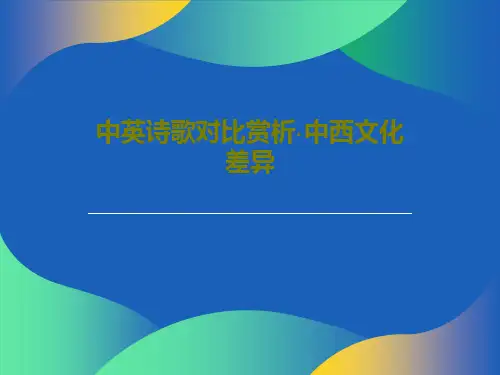

东西方诗歌文化差异会计学院Z10061143100603侯文君东西方诗歌文化差异摘要:诗歌作为一种自我表达和表现诗人对世界的诗性理解, 在形式上分行 排列,并具有一定的节奏韵律的文体,在各种文体中出现的最早,主要有叙事诗 和抒情诗。
限于课时的有限,这里只讨论中西抒情诗的异同。
关键词:诗歌,中西方,音节,抒情一、 中西抒情诗的产生及传统。
中西抒情诗的产生都是个人意识增强的结果。
但其中的个人意识有所不同。
西方古代抒情诗要求抒发个人主观的思想情感; 中 国古代抒情诗总是把个人价值蕴含于社会价值之中,即“小我”之中有“大我” 0二、 中西诗歌情趣。
中西方诗个的不同品格,主要源于社会文化的差异。
中国文化建立在儒道的基础上。
儒家重人事、伦理教化,内圣外王,修身齐 家治国平天下,追求人与人、人与社会的和谐、成为儒家的最高理想。
这使中国 诗歌亦强调诗的教化作用、使用价值。
而追求人的精神超脱、回归自然的道家, 归根结底仍是偏重人事 老子老于世故,庄子的超越精神走向的亦是齐生死、 泯物我、一是非,而不是西方式的宗教世界。
因而,对于中国诗人来说,他们不 满现实之余,在寻求解脱之时,自然往往成为他们唯一的皈依,因而,中国诗人 很少离开人事去穷尽宇宙的本源、精神的本质。
希腊文化和基督教精神,使西方 文化一方面重感情、重现世享乐,另一方面又具有一种彼岸超越意识。
这使得西 方诗歌一方面在大力弘扬英雄主义、 现实关注中又常常保持一种超越精神, 寻求的宗教精神时时贯穿于诗歌之中,使不少诗歌往往有一个主宰宇宙的神明高 居其上或蕴含其中。
从《荷马史诗》、《神曲》、《浮士德》、华兹华斯、拜伦、雪 雨果到艾略、叶芝、瓦雷拉……莫不如此。
中西方不同的文化背景,导致中国诗人更多致力于人与社会现实伦理的沟 人与自然的默契;西方诗人则更偏重于揭示人与自我、人与神的关系。
鉴于 下面仅就爱情与自然两大主题,探讨中西抒情诗的差异。
(一)、爱情抒情诗个人主义精神,渲染人之常情,另一方面在 寻求人的终极拯救,因而代表终极价值的 莱、 通, 此,中西爱情诗都历史悠久,但情趣各异。
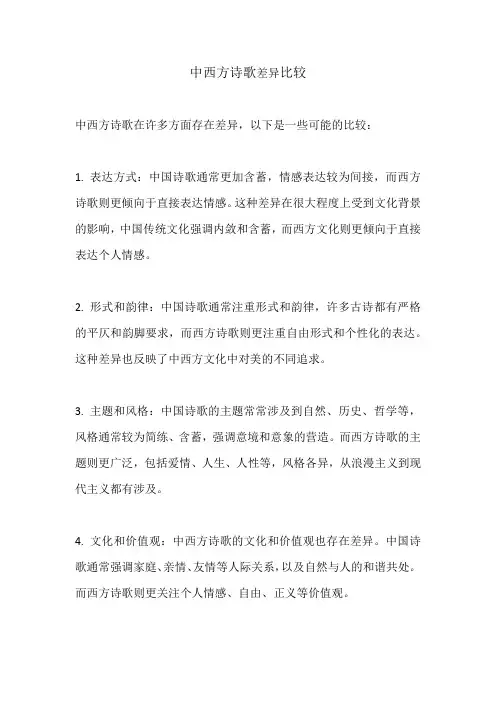
中西方诗歌差异比较
中西方诗歌在许多方面存在差异,以下是一些可能的比较:
1. 表达方式:中国诗歌通常更加含蓄,情感表达较为间接,而西方诗歌则更倾向于直接表达情感。
这种差异在很大程度上受到文化背景的影响,中国传统文化强调内敛和含蓄,而西方文化则更倾向于直接表达个人情感。
2. 形式和韵律:中国诗歌通常注重形式和韵律,许多古诗都有严格的平仄和韵脚要求,而西方诗歌则更注重自由形式和个性化的表达。
这种差异也反映了中西方文化中对美的不同追求。
3. 主题和风格:中国诗歌的主题常常涉及到自然、历史、哲学等,风格通常较为简练、含蓄,强调意境和意象的营造。
而西方诗歌的主题则更广泛,包括爱情、人生、人性等,风格各异,从浪漫主义到现代主义都有涉及。
4. 文化和价值观:中西方诗歌的文化和价值观也存在差异。
中国诗歌通常强调家庭、亲情、友情等人际关系,以及自然与人的和谐共处。
而西方诗歌则更关注个人情感、自由、正义等价值观。
5. 读者和接受方式:中西方诗歌的读者和接受方式也存在差异。
中国诗歌的读者通常较为固定,多为知识分子或文人墨客,而西方诗歌的读者则更加广泛,包括不同社会阶层和文化背景的人群。
此外,中西方诗歌的传播方式和接受方式也存在差异,中国诗歌通常通过手抄本或印刷本传播,而西方诗歌则更依赖于出版和媒体传播。
总之,中西方诗歌在许多方面都存在差异,这些差异反映了中西方文化、历史、价值观等方面的不同。
通过比较中西方诗歌,可以更好地理解两种文化的特点和异同。
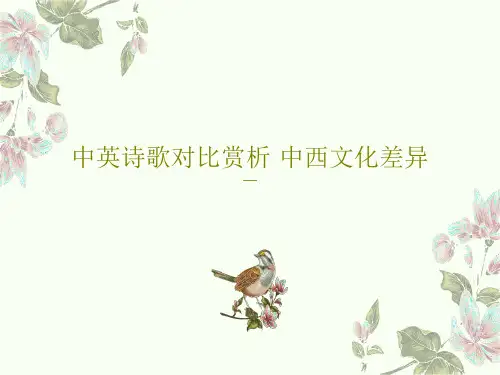
中英诗歌比较——从诗歌角度看文化差异诗歌是一种主情的文学体裁,它以主要以抒情的方式,高度凝练,反映社会生活,用丰富的想象、富有节奏感、韵律美的语言和分行排列的形式来抒发思想情感并能让他人能同样限度地理解和感受到它。
中国的诗歌历来以精炼的语言、优美的意境为其标志特征,西方(这里主要讲英国)的诗歌同样的耀眼夺目。
中西的诗歌在内容、结构等诸多方面存在不同之处,但也不难发现它们之间的联系。
对中西诗歌进行比较既是文化交流的客观必要,也是研究和发展我国诗歌的主观要求。
对于学习诗歌的人来说不可以把自己的视野放得太狭窄,在横向和纵向中不断的比较从而完善自己。
不同民族的文学在平行发展的过程中会出现殊途同归的现象。
中英的诗歌虽然有各自不同的历史文化底蕴,但我们从中还是可以寻找到彼此的影子。
中国的诗歌长期处于世界领先的地位,在很长的一段时间内西方的诗歌或多或少都受到中国诗歌的影响。
美国著名意象派诗人庞德曾经在中国文学中发现一个“新希腊”,动了一场新的“文艺复兴”。
近代以来,中国诗人,如胡适、徐志摩、郭沫若、闻一多等都曾译介过雪莱、济慈(John Keats)和惠特曼(Walt Whitman)等诗人的作品,并受其启发,于“五四”新文学时期,兴起新诗运动,极大地深化了中国新诗的思想内涵。
如当代中国的朦胧诗在很大程度上是受了西方的意象派的影响。
相似之处中国古典诗词用词凝练,意境含蓄,诗画合一,形象生动的特点在交流中融入了英美现代诗人的诗歌创作中,我们先来比较下面的两首诗:饮酒(晋)陶渊明结庐在人境,而无车马喧。
问君何能尔,心远地自偏。
采菊东篱下,悠然见南山。
山气日夕佳,飞鸟相与还。
此中有真意,欲辩已忘言。
茵纳斯弗利岛(爱尔兰)威廉·巴勒斯·叶芝我就要动身去了,去茵纳斯弗利岛;搭起一个小屋子,筑起泥巴房;支起几行云豆架,一排蜂蜜巢,独个儿住着,荫阴下听蜂群歌唱。
………不管我站在车行道或灰暗的人行道,都在心灵深处听见这声音。